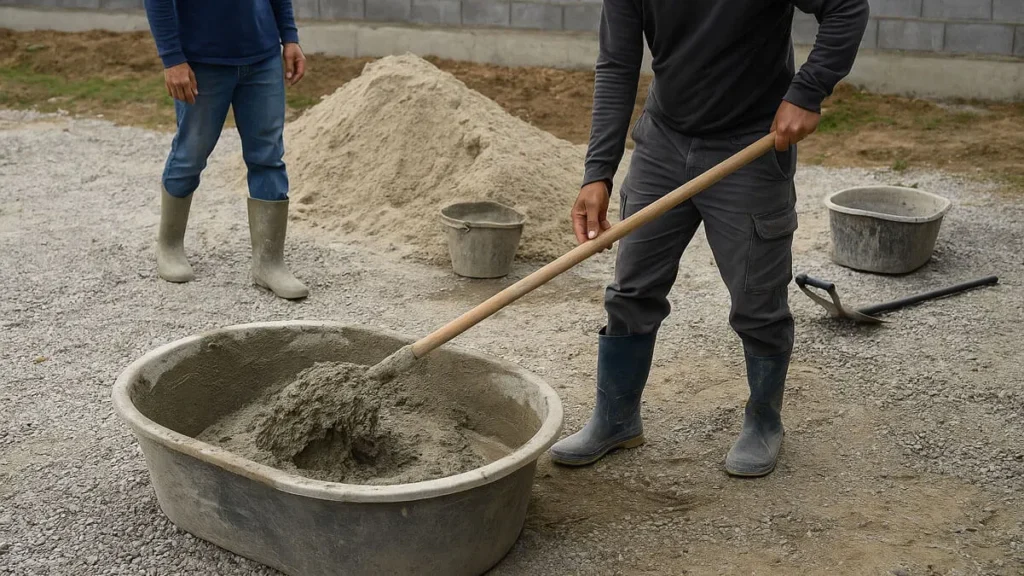How Much Concrete Do I Need


To plan a concrete project starts with a simple but important question that how much concrete do I need? Getting the right amount can help you to avoiding wasted material, added costs, or unexpected delays by working on a driveway, patio, or a small footing. Without an accurate estimate, you risk buying too much and overspending or buying too little and pausing the job mid-way.
Figuring Out What You’re Pouring
Each project has its own shape, size, and purpose. Some pours are flat and wide, like sidewalks or slabs. Others might be small but deep, like post holes or footings. Knowing what you’re building will guide you toward the right measurements. Concrete is measured in cubic yards. To find that, you need to calculate the area’s volume in feet, then convert it.
Take the time to measure the length, width, and thickness of the space you plan to fill. These three numbers multiplied together give you the total in cubic feet. Since one cubic yard equals twenty-seven cubic feet, dividing your number by twenty-seven gives you the volume you need in cubic yards.
Measuring Uneven Ground or Odd Shapes
Some projects are simple rectangles, but others might have curves, slopes, or changes in height. When dealing with these, break the area into smaller, more manageable parts. Measure each one separately, then add them together for the full amount.
If the surface is uneven or angled, take measurements from several points to find the average thickness. For example, if one side is three inches deep and the other is five inches deep, your average depth is four inches. Using that average will give you a more balanced and accurate estimate.
Dealing With Depth and Load Requirements
Depth matters when it comes to concrete. A walkway used only by foot traffic doesn’t need to be as thick as a driveway supporting heavy cars. Four inches is typical for patios and sidewalks, while driveways often require five or six inches. Slabs holding equipment or sheds might need even more.
Be sure to confirm the thickness that suits your project’s purpose. If the concrete is too thin, it may crack or break. Too thick, and you might spend more money than needed. Matching the depth to the load ensures strength and durability while keeping costs under control.
Converting Numbers Into Concrete
Once you have your volume in cubic feet, divide it by twenty-seven to convert it into cubic yards. For example, a slab that’s 10 feet long, 10 feet wide, and 4 inches thick equals 33.3 cubic feet. Divide that by twenty-seven, and you’ll need a bit more than 1.2 cubic yards of concrete.
Most suppliers sell concrete in full or half-yard amounts, so rounding up slightly ensures you have enough. Keep in mind that it’s better to have a small amount left over than to run short when you’re halfway through a pour.
Ordering With Extra in Mind
Even careful estimates can fall short if the forms shift or the ground absorbs more than expected. To avoid this, add a little extra to your order—usually around five to ten percent more than your calculated amount. This helps cover small changes, unexpected gaps, or surface settling.
If you’re working on a tight budget or have limited mixing space, calculate how many 80-pound bags you’d need instead. Each 80-pound bag covers about 0.6 cubic feet. Divide your total cubic feet by 0.6 to find the number of bags. This approach works well for small areas or when mixing by hand.
Deciding Between Bagged and Delivered Concrete
Small pours, such as garden steps or single fence posts, can often be done with bagged concrete. It’s affordable, easy to store, and can be mixed as needed. For large slabs, driveways, or foundations, ordering concrete by the truck is more practical. Ready-mix trucks deliver fresh, consistent batches that are poured quickly.
Delivery often requires a minimum order, so check with your local supplier. If your project is close to the minimum or just over it, you may save time and labor by going with the truck. Just make sure the site is ready when the truck arrives—once the mix is poured, you have limited time before it begins to set.
Factoring in Site Conditions
Soil, temperature, and layout can affect how concrete behaves. Sandy or soft soil might require a gravel base to support the pour. High heat or dry air can cause the surface to dry too quickly, which might weaken the finish. Sloped areas may need forms built deeper on one side to keep the pour level.
These site conditions might change how much concrete you need. For example, deeper forms on one end may add volume. Always double-check measurements after preparing the area. A slight change in depth or width can add or reduce several cubic feet, which matters when ordering concrete.
Staying on Track During the Pour
Once the concrete arrives, work begins quickly. Having extra hands on-site and tools ready helps you use the material before it sets. Pouring evenly and using the right tools to smooth and level the surface avoids low spots or thin sections.
Keeping track of how much is poured in each section helps monitor progress and spot problems early. If a section takes more than expected, check your form depth and base layer for issues. Adjustments during the pour may require small changes in how much you use in the remaining sections.
Avoiding Waste and Reducing Mistakes
Waste can happen when you overestimate, mix too much, or fail to plan the pour correctly. Careful measurements, along with proper planning and preparation, reduce this risk. Ordering only what you need, plus a small extra amount, balances the job without excess cost.
If extra concrete remains after the job is done, it can be poured into small molds to make stepping stones or left to cure in a bucket and discarded later. Never wash fresh concrete into drains or soil—it must be handled properly to avoid damage or pollution.
Read more: How Long Does Concrete Take to Dry?
Wrapping Up With a Solid Finish
Once your project is complete, let the concrete cure properly. Keep it moist for at least a few days to reduce cracking. Avoid heavy weight or foot traffic until it hardens fully. A good concrete finish lasts for years and supports whatever load it was designed for.
Asking how much concrete do I need is more than just a number—it’s about planning, measuring, and understanding every part of the project. Getting it right from the start means fewer delays, stronger results, and a clean, solid finish every time.

